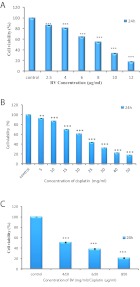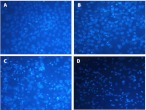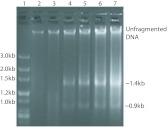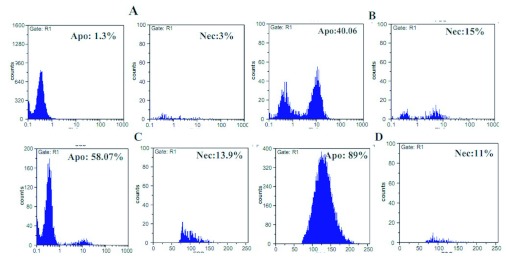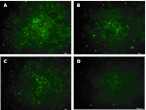Abstract
Ovarian cancer is considered to be one of the most important causes of death among women. Cisplatin is one of the oldest chemotherapeutical compounds used for treating ovarian cancer. Previous studies have shown the inhibitory effects of bee venom on certain types of cancer. The aim of the present study was to evaluate the cytotoxic effect of bee venom alone and its synergistic cytological effects in combination with cisplatin on ovarian cancerous cisplatin resistant A2780cp cells. To investigate the cytotoxic effect of bee venom on A2780cp cells and its synergetic effect with cisplatin, MTT assay, morphological examination, DNA fragmentation assay, flowcytometric and immunocytochemical analysis were performed. MTT assay revealed that 8µg/ml bee venom, 25mg/ml cisplatin and 4µg/ml bee venom/10mg/ml cisplatin cause an approximately 50% A2780cp cell death after 24hr. Morphological and biochemical analysis indicated an apoptotic type of cell death induced by bee venom and cisplatin, separately and in combination. Immunocytochemistry demonstrated a reduction in the levels of the Bcl2 protein. Overall, our findings suggest that components of bee venom may exert an anti-tumor effect on human ovarian cancer and that has the potential for enhancing the cytotoxic effect of the antitumor agent cisplatin.
Keywords: A2780cp, cisplatin, bee venom, apoptosis, ovarian cancer
INTRODUCTION
Ovarian cancer (OC) is considered to be the fourth cancer-related cause of death among women (Russ et al, 2009). Initial debulking surgery, which is followed by chemotherapy and radiation, are the common ways of treating this type of cancer (Sabatier et al, 2009). Although, no particular environmental risk factors have been associated with the ovarian carcinogenesis, nevertheless the sex hormone exposure and patient's reproductive history seems to have significant roles. In the general population, the birth of one live child may reduce the risk of OC. In addition, multiple pregnancies reduce the risk of OC. About 90% of ovarian cancers arise originally from ovaries with an unknown reason, while the remainder has hereditary background, or are associated with breast and colon cancers (Lyncha et al, 2009).
Apoptosis is a highly regulated, energy-dependent suicide program, whereby the cell activates a signaling cascade, which leads to cell death without targeting an inflammatory response. Apoptosis is mediated by two distinct evolutionarily conserved pathways: the extrinsic and intrinsic cell death pathways (Danial and Korsmeyer, 2004). Mmitochondria play a central role in the intrinsic pathway (Zou et al, 1999). This pathway is regulated by members of the Bcl-2 family that contain pro- and anti-apoptotic proteins. These proteins share as many as four conserved regions known as Bcl-2 homology (BH) domains (Adams and Cory, 1998). Antiapoptotic members such as Bcl-2 and Bcl-XL promote cell survival by inhibiting the function of the proapoptotic Bcl-2 proteins. Antiapoptotic Bcl-2 proteins have critical roles in cell survival, and protect cells from many different apoptotic stimuli (Nakayama et al, 1993; Veis et al, 1993; Motoyama et al, 1995; Opferman et al, 2003).
Cisplatin (cis-diamminedichloroplatinum II) is one of the most commonly used anticancer drugs. This compound is used alone or in combination with other chemotherapeutic agents to treat several types of solid tumors, including head and neck, ovarian and lung cancers (Cooley et al, 1994). Several experiments have demonstrated that DNA is the primary intracellular target for cisplatin (Cohen and Lippard, 2001). Cisplatin binds to the N7 reactive center on purine residues which can cause DNA damage in cancer cells, blocking the division of cancer cells and resulting in cell death. In addition, apoptosis can also cause cell death (Saeidifar et al, 2009). Despite the initial effectiveness, long term applications have failed due to the development of resistant cells not only to platinum compounds, but also to a wide range of other chemotherapeutic agents (Akdi et al, 2002; Ronconi et al, 2005; Martínez et al, 2007).
Honey bee (Apis mellifera) venom (BV) is a very complex mixture of active peptides, enzymes, and amines. Melittin and phospholipase A2 are the major components of BV. BV has been used as a traditional medicine to treat various diseases such as arthritis, rheumatism, back pain and skin diseases. Recent studies have reported that BV can cause growth arrest, and that it possesses cytotoxic effects on several types of cancerous cells (Son et al, 2007).
In this study we demonstrate that bee venom can induce apoptosis in cisplatin resistant A2780cp cells. We also examine the synergistic effects of BV and cisplatin to obtain the lowest lethal concentrations of these chemotherapeutic compounds.
MATERIALS AND METHODS
Cell culture
The human ovarian cancer A2780cp cells were purchased from NCBI (National Cell Bank of Iran). Cells were cultured in RPMI-1640 (Gibco-Invitrogene) with 10% (v/v) fetal bovine serum (FBS, Gibco-Invitrogene) and antibiotics (100U/ml penicillin and 100mg/ml streptomycin) at 37°C in a 5% (v/v) CO2 humidified incubator. The medium was changed every 48hr.
MTT Assay
A2780cp cells were cultured in 24-well plates. They were then treated with different concentrations of BV (BV was collected from Isfahan Province in Iran) or cisplatin as well as BV and cisplatin together for 24hr. Viability was determined by MTT assay. Briefly, 50µl MTT (3-[4,5-dimethylthiazol-2-yl]-2,5-diphenyltetrazolium bromide; Sigma) solution was added to each well, and cells were incubated at 37°C for 3-4hr in dark. Subsequently, the medium was removed and 1ml of dimethylsulfoxide was added to each well, and the plates were kept at room temperature for 30min. The absorbance was measured at 570nm. The percent viability was calculated as follows:
 |
DNA fragmentation analysis
A distinctive feature of apoptosis at the biochemical level is DNA fragmentation. DNA fragmentation was inspected as a semiquantitative method of measuring apoptosis. A2780cp cells were exposed to different concentrations of cisplatin and BV, separately and in combination for 24hr. QIAamp DNA mini Kit was used for DNA purification. Purified DNA was resuspended in 20µl TAE buffer supplemented with 2µl of sample buffer (0.25%, w/v, bromphenol blue, 30% v/v, glyceric acid), and electrophoretically separated on a 1.5% (w/v) agarose gel, containing 1µg/ml ethidium bromide, and visualized under an ultraviolet transilluminator.
Flow cytometry
Apoptosis was measured using a quantitative flowcytometry assay. Briefly, treated and non-treated cells were trypsinized and washed with PBS, centrifuged (1500rpm for 5min), and the supernatant was aspirated. After washing, samples were incubated with 100µl of the Annexin-V primary antibody (diluted 1:100 in the blocking buffer 3%, w/v, BSA in PBS) overnight at 4°C. These cells were then washed with PBS and centrifuged (2000rpm for 10min). Cells were incubated in the dark with 100µl fluorescein-labeled goat anti-rabbit secondary antibody (diluted 1:100 in blocking buffer 3%, w/v, BSA PBS) for 45min at 37°C. After washing with PBS and centrifugation (2000rpm for 10min), 5µl of PI (propidium iodide) was added and kept for 20min before washing for three times with the wash buffer. Finally, 500µl of 0.01% (v/v) formaldehyde was added to each tube, and Annexin-V expression was measured immediately using a Becton Dickinson FACScan analyzer.
Immunocytochemistry
Following the exposure of A2780cp cells to different concentrations of BV and cisplatin for 24hr, cells were used for immunocytochemical examination of Annexin-V and Bcl2 expression. Briefly, cells were washed with PBS and fixed in 4% PFA for 20min, followed by a three times wash with PBS. The wells were rinsed with 0.05% (v/v) Triton X-100 and blocked with 1% (w/v) BSA in PBS for 45min prior to incubation with a 1:100 dilution of Annexin-V and Bcl2 primary antibodies, separately. After an overnight incubation with the primary Ab at 4°C, cultures were incubated in the dark with a fluorescein-labeled goat antibody against rabbit IgG for 45min at 37°C. For nuclear staining, an incubation with 0.1 µg/ml DAPI was performed. Finally, cells were washed in PBS solution, and mounted for microscopic visualization.
RESULTS
MTT cell viability assay
To examine the cytotoxic effects of BV and cisplatin alone and in combination (BV/cisplatin) on human ovarian cancer A2780cp cell line, cells were cultured with different concentrations of BV and cisplatin for 24hr. Cell viability was determined by MTT assay. As shown in Figure 1A and B, they both have cytotoxic effect on A2780cp cells in a dose-dependent manner. Treatment with 8µg/ml BV or 25mg/ml cisplatin for 24hr caused an approximately 50% A2780cp cell death. The subsequent experiments were performed using these values as lethal dosages of each compound. For a simultaneous treatment with both BV and cisplatin, 4µg/ml BV plus 10mg/ml cisplatin for 24hr caused an approximately 50% A2780cp cell death (Figure 1C).
Figure 1.
Dose dependent effects of BV, cisplatin and BV/cisplatin in resistant ovarian cancer cells (A2058cp). A2058cp cells were incubated with the indicated doses of BV (A) cisplatin (B) and BV/cisplatin (C). Growth inhibition and cell death were determined by MTT assay after 24hr. Results are expressed as means ±SEM of data obtained in three independent experiments. The data are statistically significant in comparison to the vehicle control by one-way ANOVA.
DAPI staining
To observe the effect of BV and cisplatin on cell morphology, cells were biochemically analyzed via DAPI staining. As shown in Figure 2, nuclear condensation and perinuclear apoptotic bodies were detected in the treated cells after 24hr. These morphological characteristics suggest that BV and cisplatin induce an apoptotic type of A2780cp cell death.
Figure 2.
Changes in nuclear condensation using DAPI staining. A2058cp cells treated with BV, cisplatin and BV/cisplatin were stained with DAPI, and cells were photographed under a fluorescence microscope. A: untreated cells (control). B: 8µg/ml BV-treated cells. C: 25mg/ml cisplatin-treated cells. D: 4µg/ml BV/10mg/ml cisplatin-treated cells. Experiments were repeated at least three times with similar results.
DNA fragmentation
DNA fragmentation is considered as one of several apoptosis characteristics that reflect endonuclease activity. As seen in Figure 3, cells treated with BV alone did not exhibit this DNA fragmentation, however, cisplatin alone and in combination with BV (BV/cisplatin) resulted in the formation of a set of defined fragments that could be seen via the electrophoretic examination as a characteristic ladder pattern.
Figure 3.
Electrophoretic analysis of genomic DNA of A2780cp cells treated with BV, cisplatin, and BV/cisplatin. Cells were incubated for 24hr. Control cells (2); 8µg/ml BV (3); 25mg/ml cisplatin(4); 4µg/ml BV/10mg/ml cisplatin (5); 6µg/ml BV/10mg/ml cisplatin (6) and 8µg/ml BV/10mg/ml cisplatin(7). Genomic DNA was extracted and analyzed by electrophoresis on a 1.5% (w/v) agarose gel containing ethidium bromide. A2780cp cells treated with BV did not exhibit the ladder pattern characteristic of apoptosis, but cells exposed to cisplatin alone and in combination with BV showed this pattern. 1, Marker; 2, Control; 3, BV-treated cells; 4, Cisplatin-treated cells; 5, 6 and 7 BV/Cisplatin -treated cells.
Cell death analysis through flowcytometry and immunocytochemistry
To further confirm that BV and cisplatin do induce apoptosis in A2780cp cells, a flowcytometric analysis with Annexin V-FITC and phosphatidylserine (PS), and an immunocytochemical assay with AnnexinV-FITC were performed. Detection of the apoptotic and necrotic rates by flowcytometry are shown in Figure 4. These results confirmed that cells exposed to 8µg/ml BV, 25mg/ml cisplatin and 4µg/ml BV/10 mg/ml cisplatin enter an early stage of apoptosis. Immunocytochemical assay (Figure 5) also revealed that phosphatidylserine (PS) is exposed to the outer membrane, and diagnosed with Annexin V-FITC in cells treated with BV, cisplatin and BV/cisplatin.
Figure 4.
Quantitative cell death analysis in A2780cp cells after treatment with different concentrations of BV and cisplatin alone and in combination by flowcytometry. The double staining of the cells was performed with Annexin V- FITC and PI to detect apoptotic and necrotic cells. Cells were cultured without any compounds (A); with 8µg/ml BV (B); with 25mg/ml of cisplatin (C) and with 4µg/ml BV/10mg/ml cisplatin (D) for 24 h. Note the increase in the apoptotic rate, when cells are exposed to these compounds, compared to the control group. Results are shown for three independent experiments.
Figure 5.
Effect of BV, cisplatin and BV/cisplatin on Annexin V expression in A2780cp cells by Immunocytochemical analysis using florescence microscopy at 200x magnification. A: control; B: 8µg/ml BV; C: 25mg/ml cisplatin and D: 4µg/ml BV/10mg/ml cisplatin. Significant increase in PS expression is seen in cells treated with BV and cisplatin alone and in combination.
Effects of BV and cisplatin on the expression of Bcl2 protein by immunocytochemistry
Effects of BV, cisplatin and BV/cisplatin on Bcl2 expression in A2780cp cells by immunocytochemistry indicated that Bcl2 expression was markedly decreased in cells treated with 8µg/ml BV, 25mg/ml cisplatin and 4µg/ml BV/10mg/ml cisplatin compared to the control group (Figure 6).
Figure 6.
Effect of BV, cisplatin and BV/cisplatin on Bcl2 expression in A2780cp cells by Immunocytochemical analysis using florescence microscopy at 100x magnification. A: control; B: 8µg/ml BV; C: 25mg/ml cisplatin and D: 4µg/ml BV /10 mg/ml cisplatin. Significant reduction in Bcl2 expression is seen in cells treated with BV and cisplatin alone and in combination.
DISCUSSION
Cisplatin and its analogues are among the most effective anticancer drugs currently used for treating different types of cancer, however, they come with serious side effects. Thus, current research has mainly focused on finding ways of reducing these severe side effects (Mansouri-Torshizi et al, 2010). The purpose of the present study was to determine whether BV, through induction of apoptosis, processes an inhibitory effect on cisplatin resistant A2780cp cells, and also weather it does have a synergistic effect with cisplatin. It was demonstrated that BV can induce apoptosis in A2780cp cells. Analysis of cytotoxicity by MTT assay confirmed the cytotoxic effects of BV in a time- and dose-dependent manner. The IC50 value determined for BV was 8µg/ml after 24hr, which is different from its lethal dosage in other cancerous cell lines (eg. About 2µg/ml for human melanoma A2058 cell lines (Tu et al, 2008) and 10µg/ml for the human lung cancer NCI-H1299 cell line (Jang et al, 2003). DNA fragmentation, as a well defined characteristic of apoptosis, was not clearly detected via agarose gel electrophoresis. Such fragments have been shown to occur in other BV-treated cells such as lung and breast cancer cell lines (Jang et al, 2003; Ip et al, 2008a). We demonstrated by dapi staining that BV induces remarkable changes in cell morphology such as nuclear shrinkage and chromatin condensation. The results of cell death analysis by flowcytometry and immunocytochemical assays showed that the type of cell death induced by BV is apoptosis. In addition to the effects mentioned above, Bcl2 as an antiapoptotic protein was shown to be downregulated.
Our data demonstrated that lethal effects of cisplatin are potentiated by the addition of a non-lethal dose of the bee venom. Orsolic (2009) investigated the cytotoxic effects of bee venom applied alone or in combination with the DNA damaging drug bleomycin on HeLa and V79 cells. Bleomycin caused a dose-dependent decrease in cell survival, and when used with a non-lethal dose of BV, its lethal effect was potentiated. He presumed that BV, by preventing the repair of damaged DNA, increases bleomycin lethality and inhibits recovery from the bleomycin-induced damage. Since DNA is the main target of cisplatin, it is very likely that BV is able to potentiate the lethal effect of cisplatin in this way. Recently, Tu et al (2008) explored the effect of BV on human melanoma A2058 cells. They reported that BV induced apoptosis in a calcium-dependent and caspase- independent pathway in human melanoma A2058 cells but not in normal skin fibroblast Detroit 551 cells. This effect of BV and melittin, the key component of bee venom, was also accompanied by the generation of reactive oxygen species (ROS) and alteration in mitochondrial membrane potential transition. Cytotoxic effects of Apis mellifera venom and its mode of action at the cellular and molecular levels were examined by Lee and coworkers in normal human lymphocytes and HL-60 cells (Lee et al, 2007). The authors showed that BV possesses selective cytotoxic properties in both normal and cancerous cells. Observations by Jang and colleagues (2003) indicated that BV induces apoptosis and inhibits the expression of cyclooxygenase-2 in the human lung cancer cell line NCI-H1299. Ip et al (2008b) examined the effect of honey bee venom on human cervical epidermoid carcinoma Ca Ski cells. They showed that bee venom induced cell cycle arrest and apoptosis in these cells through both caspase-dependent and caspase-independent pathways. They suggested that apoptosis occurred via a Fas receptor pathway. These authors used flowcytometry to show that BV-triggered apoptosis was accompanied by ROS generation, an increase in the level of cytoplasmic Ca2+, a reduced mitochondrial membrane potential which led to cytochrome c release, and the activation of caspase-3. Bee venom also upregulated Fas, p53, p21, Bax, caspase-8 and caspase-9 expression, but downregulated Bcl-2 expression. BV caused the release of apoptosis-inducing factor (AIF) and endonuclease G (Endo G) from mitochondria, which led to apoptosis via the caspase-independent pathway in Ca Ski cells. These results are in agreement with other reports on other cell lines such as human breast cancer MCF7 cells [Ip et al, 2008a) and U937 cells (Moon et al, 2008). Park et al (2010) demonstrated that bee venom and its major component melittin cause apoptotic cell death in prostate carcinoma LNCaP, DU145, and PC-3 cells via activation of caspase-3 through inactivation of NFκB both in vitro and in vivo. These authors also indicated that this anticancer effect of BV was correlated with an increase in the levels of various proliferative and antiapoptotic gene products, including Bcl-2, cIAP-2, XIAP, iNOS, COX-2, and cPLA2, which are regulated by NFκB. Their immunohistochemical analysis of the tumor section by H&E, and the proliferation antigens against PCNA along with Ki-67 staining data revealed that bee venom inhibited tumor cell growth in a dose-dependent manner. In conclusion, our results indicate that bee venom represents a potential candidate for clinical tests to further prove its potential as an anti-cancer agent in the treatment of ovarian cancer. Furthermore, in the light of our results, bee venom can be used to improve the cytotoxic effects of customary chemotherapeutic agents.
ACKNOWLEDGEMENTS
This project was performed in the Laboratory of Cell and Developmental Biology at Kharazmi University and the authors would like to thank all lab members, Fatemeh Alizadehnohi and my brother in law Dimitry Chesnakof for their support.
LIST OF ABBREVIATIONS
- PS
Phosphatidylserine
- BV
Bee venom
- Cisplatin
cis-diamminedichloroplatinum II
- OC
Ovarian cancer
COMPETING INTERESTS
None declared.
REFERENCES
- Adams JM, Cory S. The Bcl-2 protein family: arbiters of cell survival. Science. 1998;281:1322–1326. doi: 10.1126/science.281.5381.1322. [DOI] [PubMed] [Google Scholar]
- Akdi K, Vilaplana RA, Kamah S, Navarro JA, Salas JM, González-Vílchez F. Study of the biological effects and DNA damage exerted by a new dipalladium-Hmtpo complex on human cancer cells. J Inorg Biochem. 2002;90:51–60. doi: 10.1016/s0162-0134(02)00370-7. [DOI] [PubMed] [Google Scholar]
- Cohen SM, Lippard SJ. Cisplatin: from DNA damage to cancer chemotherapy. Prog Nucleic Acid Res Mol Biol. 2001;67:93–130. doi: 10.1016/s0079-6603(01)67026-0. [DOI] [PubMed] [Google Scholar]
- Cooley ME, Davis LE, DeStefano M, Abrahm J. Cisplatin: a clinical review. Part I. Current uses of cisplatin and administration guidelines. Cancer Nursing. 1994;17:173–184. [PubMed] [Google Scholar]
- Danial NN, Korsmeyer SJ. Cell death: critical control points. Cell. 2004;116:205–219. doi: 10.1016/s0092-8674(04)00046-7. [DOI] [PubMed] [Google Scholar]
- Ip SW, Liao SS, Lin SY, et al. The role of mitochondria in bee venom-induced apoptosis in human breast cancer MCF7 cells. In Vivo. 2008a;22:237–45. [PubMed] [Google Scholar]
- Ip SW, Wei HC, Lin JP, et al. Bee venom induced cell cycle arrest and apoptosis in human cervical epidermoid carcinoma Ca Ski cells. Anticancer Res. 2008b;28:833–42. [PubMed] [Google Scholar]
- Jang MH, Shin MC, Lim S, et al. Bee venom induces apoptosis and inhibits expression of cyclooxygenase-2 mRNA in human lung cancer cell line NCI-H1299. J Pharmacol Sci. 2003;91:95–104. doi: 10.1254/jphs.91.95. [DOI] [PubMed] [Google Scholar]
- Lee YJ, Kang SJ, Kim BM, Kim YJ, Woo HD, Chung HW. Cytotoxicity of honeybee (Apis mellifera) venom in normal human lymphocytes and HL-60 cells. Chemico-Biological Interactions. 2007;169:189–197. doi: 10.1016/j.cbi.2007.06.036. [DOI] [PubMed] [Google Scholar]
- Lyncha HT, Caseyb MJ, Snydera CL, et al. Hereditary ovarian carcinoma: heterogeneity, molecular genetics, pathology, and management. Mol Oncol. 2009;3:97–137. doi: 10.1016/j.molonc.2009.02.004. [DOI] [PMC free article] [PubMed] [Google Scholar]
- Mansouri-Torshizi H, Saeidifar M, Divsalar A, Saboury AA, Shahraki S. Interaction studies of a novel, water-soluble and anti-cancer Palladim(II) complex with calf thymus DNA. Bull. Korean Chem Soc. 2010;31:435–441. [Google Scholar]
- Martínez A, Lorenzo J, Prieto MJ, et al. Influence of the position of substituents in the cytotoxic activity of trans platinum complexes with hydroxymethylpyridines. Bioorg Med Chem. 2007;15:969–79. doi: 10.1016/j.bmc.2006.10.031. [DOI] [PubMed] [Google Scholar]
- Moon DO, Park SY, Choi YH, Kim ND, Lee C, Kim GY. Melittin induces Bcl-2 and caspase-3-dependent apoptosis through downregulation of Akt phosphorylation in humanleukemic U937 cells. Toxicon. 2008;51:112–20. doi: 10.1016/j.toxicon.2007.08.015. [DOI] [PubMed] [Google Scholar]
- Motoyama N, Wang F, Roth KA, et al. Massive cell death of immature hematopoietic cells and neurons in Bcl-x-deficient mice. Science. 1995;267:1506–1510. doi: 10.1126/science.7878471. [DOI] [PubMed] [Google Scholar]
- Nakayama K, Nakayama K, Negishi I, et al. Disappearance of the lymphoid system in Bcl-2 homozygous mutant chimeric mice. Science. 1993;261:1584–1588. doi: 10.1126/science.8372353. [DOI] [PubMed] [Google Scholar]
- Opferman JT, Letai A, Beard C, Sorcinelli MD, Ong CC, Korsmeyer SJ. Development and maintenance of B and T lymphocytes requires antiapoptotic MCL-1. Nature. 2003;426:671–676. doi: 10.1038/nature02067. [DOI] [PubMed] [Google Scholar]
- Orsolic N. Potentiation of Bleomycin lethality in HeLa and V79 cells by bee venom. Arh Hig Rada Toksikol. 2009;60:317–326. doi: 10.2478/10004-1254-60-2009-1936. [DOI] [PubMed] [Google Scholar]
- Park MH, Choi MS, Kwak DH, et al. Anti-cancer effect of bee venom in prostate cancer cells through activation of caspase pathway via inactivation of NF-kB. The Prostate. 2010;71:801–812. doi: 10.1002/pros.21296. [DOI] [PubMed] [Google Scholar]
- Ronconi L, Giovagnini L, Marzano C, et al. Gold dithiocarbamate derivatives as potential antineoplastic agents: design, spectroscopic properties, and in vitro antitumor activity. Inorgan Chem. 2005;44:87–93. doi: 10.1021/ic048260v. [DOI] [PubMed] [Google Scholar]
- Russ A, Calo V, Bruno L, Rizzo S, Bazan V, Fede GD. Hereditary ovarian cancer. Critical Rev Oncol/Hematol. 2009;69:28–44. doi: 10.1016/j.critrevonc.2008.06.003. [DOI] [PubMed] [Google Scholar]
- Sabatier R, Finett P, Cervera N, Birnbaum D, Bertucci F. Gene expression profiling and prediction of clinical outcome in ovarian cancer. Critical Rev Oncol/Hematol. 2009;72:98–109. doi: 10.1016/j.critrevonc.2009.01.007. [DOI] [PubMed] [Google Scholar]
- Saeidifar M, Mansouri-Torshizi H, Rezaei Behbehani G, Divsalar A, Saboury AA. A thermodynamic study of new designed complex of ethylendiamine 8-hydroxyquinolinato Palladium(II) chloride with calf thymus DNA. Bull Korean Chem Soc. 2009;30:1951–1955. [Google Scholar]
- Son J, Lee JW, Lee YH, Song HS, Lee CK, Hong JT. Therapeutic application of anti-arthritis, pain-releasing, and anti-cancer effects of bee venom and its constituent compounds. Pharmacol Therapeutics. 2007;115:246–270. doi: 10.1016/j.pharmthera.2007.04.004. [DOI] [PubMed] [Google Scholar]
- Tu WC, Wu CC, Hsieh HL, Chen CY, Hsu SL. Honeybee venom induces calcium-dependent but caspase-independent apoptotic cell death in human melanoma A2058 cells. Toxicon. 2008;52:318–329. doi: 10.1016/j.toxicon.2008.06.007. [DOI] [PubMed] [Google Scholar]
- Veis DJ, Sorenson CM, Shutter JR, Korsmeyer SJ. Bcl-2-deficient mice demonstrate fulminant lymphoid apoptosis, polycystic kidneys, and hypopigmented hair. Cell. 1993;75:229–240. doi: 10.1016/0092-8674(93)80065-m. [DOI] [PubMed] [Google Scholar]
- Zou H, Li Y, Liu X, Wang X. An APAF1-cytochrome c multimeric complex is a functional apoptosome that activates procaspase-9. J Biol Chem. 1999;274:11549–11556. doi: 10.1074/jbc.274.17.11549. [DOI] [PubMed] [Google Scholar]



